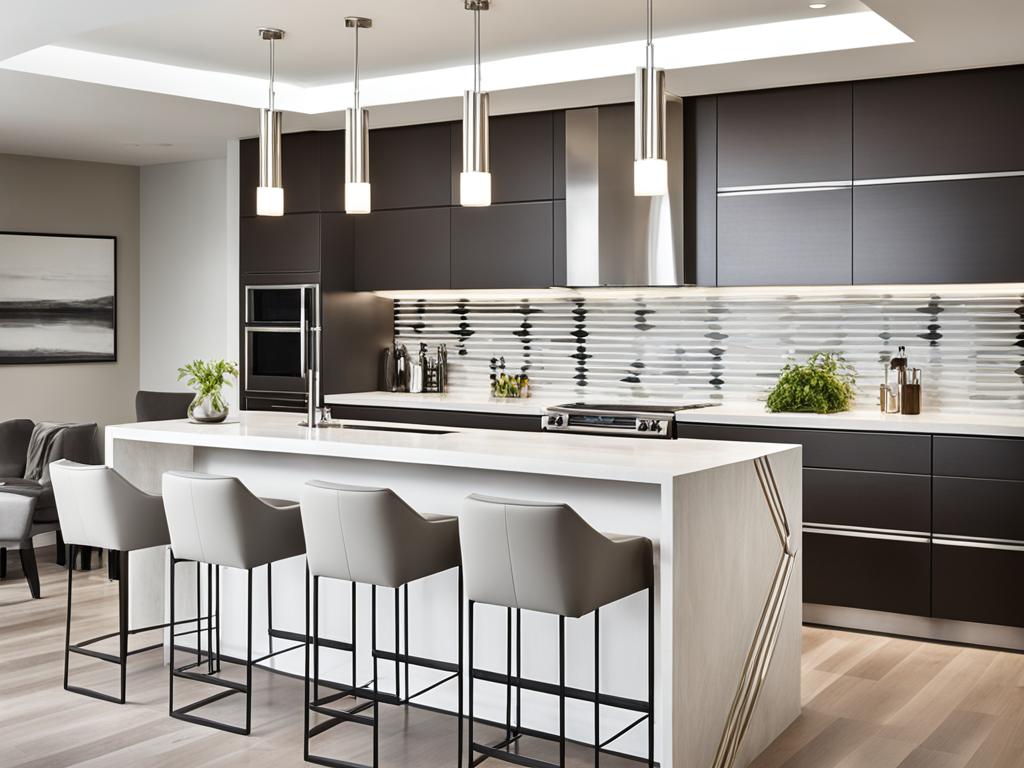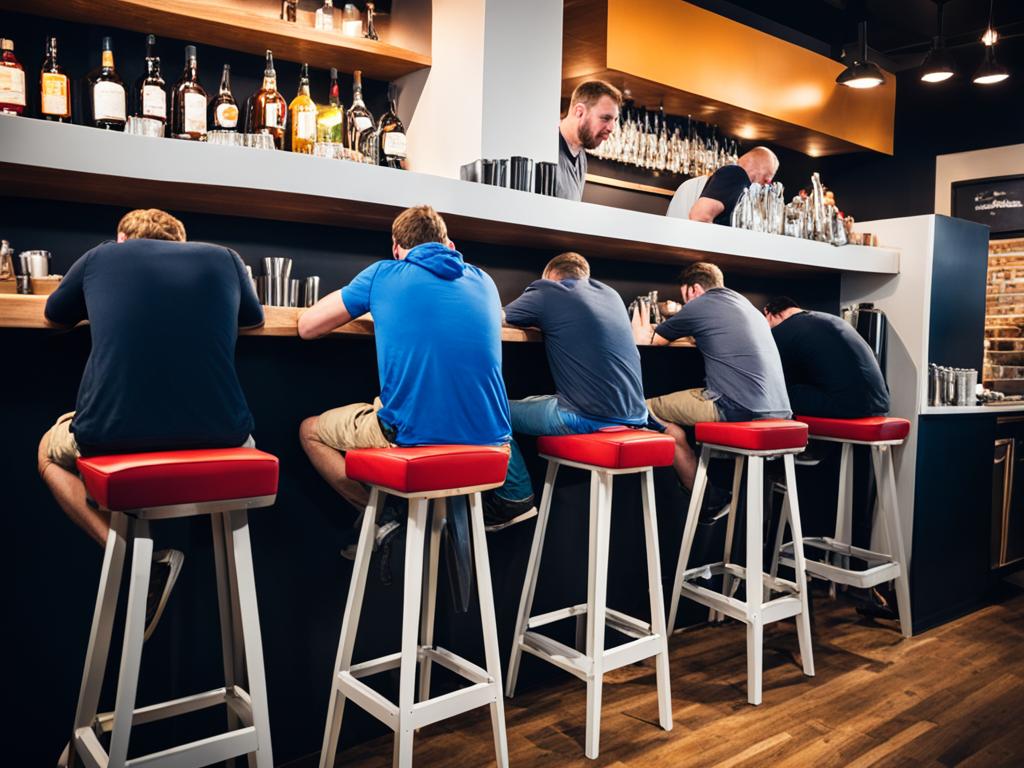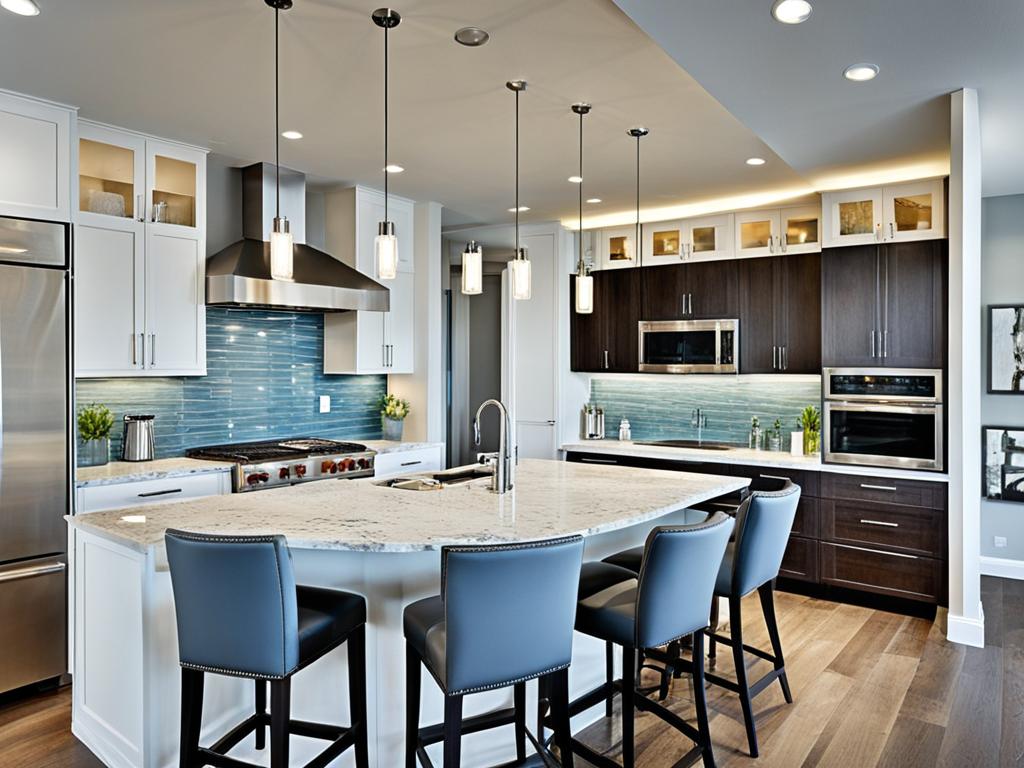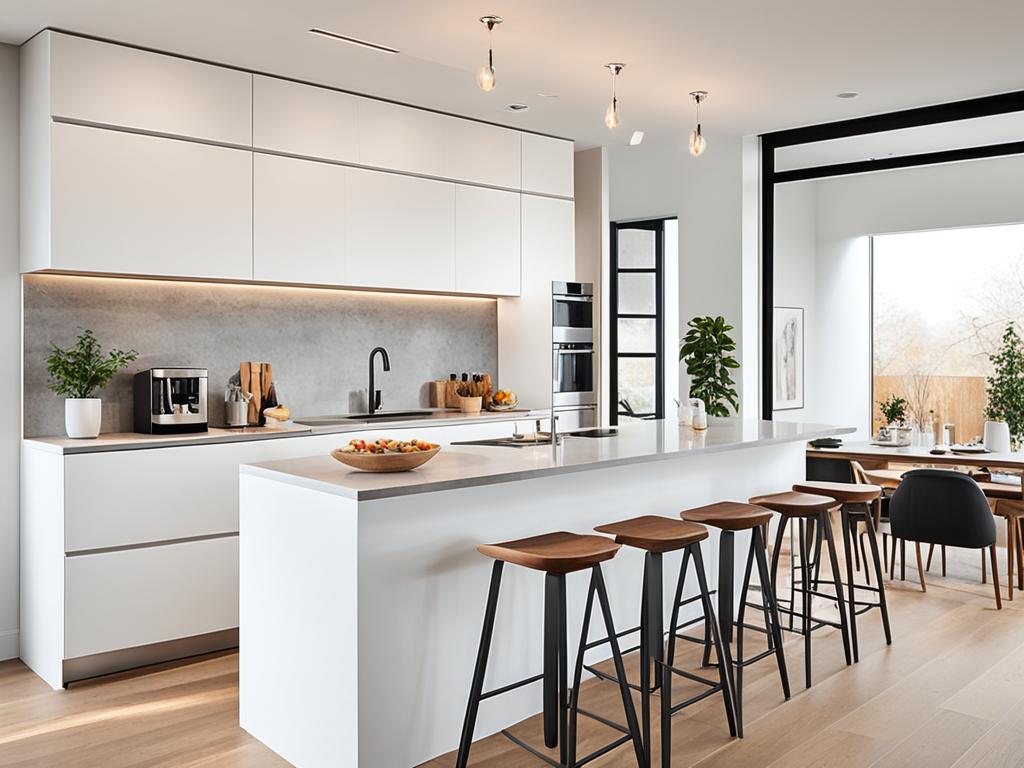When designing a kitchen layout, one common question is whether to choose a raised breakfast bar or a flat option. Both styles have their advantages and disadvantages that should be considered before making a decision. In this article, we will explore the pros and cons of raised breakfast bars versus flat options to help you make an informed choice for your kitchen renovation.
Key Takeaways:
- Raised breakfast bars can provide privacy and clutter concealment
- Flat options offer a continuous work surface and visibility
- Raised breakfast bars require taller stools and may require additional clean up
- Flat options lack room definition and privacy
- Your choice depends on personal preferences and needs for your kitchen renovation
What is Bar Height Seating?
Bar height seating refers to an elevated counter or bar height counter seating that is typically about 41″-43″ off the floor to the countertop. This design feature is approximately 6″ higher than the standard kitchen counter height of 35″-40″.
The raised countertop can help conceal a busy workspace and clutter from view, making it a suitable option for open floor plans. It can also act as a room divider and allow for interaction between the cook and family or guests without them being in the work area.

Bar height seating adds an elevated eating area in your kitchen, creating a distinct and stylish space for dining. It is an excellent choice for individuals who enjoy a more casual and social dining experience or for entertaining guests while preparing meals.
“Bar height seating adds a touch of elegance and sophistication to any kitchen design. It provides a unique elevated eating area that’s perfect for breakfast or quick meals. The raised counter also creates a visual separation between the kitchen and dining space, making it a versatile option for open floor plans.”
– Interior Design Expert, Sarah Thompson
The Pros of Bar Height Seating
Bar height seating provides numerous advantages that enhance both the aesthetic appeal and functionality of your kitchen. By opting for a raised countertop, you can enjoy the following benefits:
- Clutter concealment: The elevated top of a bar height seating arrangement discreetly hides any clutter and dirty dishes from view, instantly creating a cleaner and more organized appearance in your kitchen. This feature is particularly beneficial if you frequently entertain guests or have an open-concept living area where the kitchen is visible from other parts of the house.
- Room division: A bar height countertop can serve as an effective room divider, delineating the kitchen space from the rest of the area. This is especially advantageous in large, open floor plans, as it helps create defined zones without compromising the flow and continuity of the overall design.
- Kitchen interaction: One of the key advantages of bar height seating is the opportunity it provides for family members and guests to engage with the cook without intruding into the work area directly. The raised top allows for easy conversation and connections while keeping the primary workspace separate and organized.
Overall, bar height seating combines practicality and design, offering a visually appealing kitchen layout that promotes social interaction and maintains a clean and tidy space for a more enjoyable culinary experience.
The Cons of Bar Height Seating
While bar height seating offers numerous benefits, it’s important to consider some of the potential drawbacks before making a decision. The following are a few cons to keep in mind:
- Tall Stools: Bar height seating typically requires taller stools, resulting in potential discomfort for small children or individuals with mobility restrictions. The elevated height, typically around 30″ off the floor, may not be practical for everyone.
- Additional Clean Up: The raised countertop in bar height seating involves wiping down two different surfaces—the counter and the stool. This may result in additional cleaning and maintenance compared to traditional counter height seating.
- Potential Clutter: The elevated counter in a bar height seating area can become a drop spot for clutter such as mail, keys, and screens. Without proper organization and discipline, this can detract from the clean and streamlined appearance of the kitchen.

Despite these drawbacks, many homeowners still find bar height seating to be a stylish and functional option for their kitchens. It ultimately comes down to personal preference and lifestyle needs.
What is Counter Height Seating?
Counter height seating refers to a standard countertop height in a kitchen, which is about 35″-40″ tall. This height works well with typical counter-height bar stools and chairs that are around 23″-28″ from the floor to the seat. With counter height seating, the kitchen island or peninsula remains at one consistent height, providing a continuous work surface. This makes it ideal for setting up a buffet or providing ample space for projects.
Counter height seating offers several advantages. First, it creates a visually appealing and spacious environment in your kitchen. The uniform height of the kitchen island or peninsula, combined with the stools or chairs, gives a cohesive and streamlined look. This design choice can make your kitchen feel larger and more open.
Additionally, counter height seating is especially practical when hosting gatherings or parties. The higher surface makes it easier for guests to serve themselves from a buffet area set up on the kitchen island. This setup encourages socializing while still allowing the host or hostess to prepare food without interruption.
Moreover, counter height seating enhances accessibility. The slightly taller stools or chairs are generally more comfortable for individuals with mobility restrictions, as they require less effort to sit down and stand up. This makes the kitchen space more inclusive and accommodating for everyone.
Take a look at the visual representation below to see the difference between counter height seating and bar height seating:

| Counter Height Seating | Bar Height Seating |
|---|---|
| Kitchen island or peninsula at counter height (35″-40″) | Kitchen island or peninsula raised (41″-43″) |
| Counter-height bar stools or chairs (~23″-28″) | Taller bar stools (~30″) |
| Provides continuous work surface | Creates a room divider |
| Ideal for buffet areas and projects | Conceals workspace clutter |
The Pros of Counter Height Seating
Counter height seating offers several advantages for your kitchen design. Let’s explore these benefits in detail:
-
Visual Spaciousness: One of the key advantages of counter height seating is the visual spaciousness it creates in your kitchen. With a one-level, continuous countertop, the room appears larger, open, and more inviting. This design choice can enhance the overall aesthetics of your kitchen and make it feel less cramped.
-
Accessibility: Counter height seating offers improved accessibility for all members of your household. The lower height of the stools or chairs required for counter height seating makes it easier for children and individuals with mobility restrictions to comfortably sit and enjoy their meals. This aspect of counter height seating promotes inclusivity and convenience in your kitchen space.
-
Convenient for Food Prep: Another benefit of counter height seating is its suitability for food preparation. The counter height provides an ideal surface for chopping, mixing, and other culinary activities. With counter height seating, you can seamlessly transition from food preparation to serving and dining, creating a functional and efficient workflow in your kitchen.
-
Visible Space for All Activities: Counter height seating ensures that everyone in the kitchen can easily engage in conversations and activities. Whether it’s cooking, socializing, or keeping an eye on children, counter height seating offers a visible space that fosters interaction and connectivity among family members and guests.
Overall, counter height seating provides a visually spacious, accessible, and versatile option for your kitchen. Its benefits extend beyond aesthetics, offering functional advantages that enhance the overall experience in your kitchen space.
| Pros of Counter Height Seating |
|---|
| Visual Spaciousness |
| Accessibility |
| Convenient for Food Prep |
| Visible Space for All Activities |
Conclusion
When it comes to choosing between a raised breakfast bar and a flat option for your kitchen layout, there are important factors to consider based on your personal preferences and needs. Raised breakfast bars offer privacy and can help conceal clutter, creating a clean and organized kitchen. They also provide a space for interaction, allowing the cook to engage with family and guests without them being directly in the work area.
However, it’s important to note that raised breakfast bars may require taller stools, which could be a challenge for small children to use comfortably. Additionally, the elevated surface may require additional clean up as it involves wiping down two different surfaces. There is also the potential for the raised bar to become a drop spot for everyday items like mail and keys.
On the other hand, flat options provide a continuous work surface that can be convenient for food prep and other kitchen activities. They offer visibility and accessibility, making it easier for everyone, including children and individuals with mobility restrictions, to comfortably use the space. However, flat options may lack the room definition and privacy that a raised breakfast bar provides.
In conclusion, assessing the pros and cons of each style, as well as considering your home renovation trends, will help you make an informed decision about the best kitchen counter options for your needs and preferences. Remember that a well-designed kitchen is not only aesthetically pleasing, but also functional and practical for everyday use.
FAQ
What are the advantages of a raised breakfast bar?
Raised breakfast bars offer privacy, clutter concealment, and interaction with guests without them being directly in the work area.
What are the disadvantages of a raised breakfast bar?
Raised breakfast bars may require taller stools, additional clean up as they involve wiping down two different surfaces, and have the potential to become a drop spot for clutter.
What is bar height seating?
Bar height seating refers to an elevated counter or bar height counter seating that is typically about 41″-43″ off the floor to the countertop, creating an elevated eating area in the kitchen.
What are the benefits of bar height seating?
Bar height seating offers concealment of clutter, room division, and allows for interaction between the cook and family or guests without them being in the work area.
What are the drawbacks of bar height seating?
The tall seating height can be challenging for small children to use comfortably, and the raised countertop may require additional clean up and become a drop spot for clutter.
What is counter height seating?
Counter height seating refers to a standard countertop height in a kitchen, which is about 35″-40″ tall, providing a continuous work surface.
What are the advantages of counter height seating?
Counter height seating creates a visually larger and more spacious room, requires shorter stools or chairs for easier navigation, and is convenient for food prep.
What should I consider when deciding between a raised breakfast bar and a flat option?
The choice depends on personal preferences and needs. Raised breakfast bars offer privacy, clutter concealment, and interaction but may require taller stools and additional clean up. Flat options provide a continuous work surface, visibility, and accessibility but may lack the room division and privacy of a raised bar.



